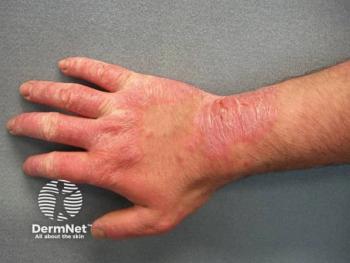
Expert Insights Highlight Novel ITK Inhibition With Soquelitinib for AD
Albert Chiou, MD, MBA, discusses early clinical data on soquelitinib for atopic dermatitis, highlighting its targeted ITK inhibition, dose-dependent efficacy, favorable safety profile, and more.
“This is the first time that a selective ITK inhibitor has been studied in atopic dermatitis or any human immune-mediated disease for that matter. I think this trial is a real step forward in giving us a potential new way to selectively target TH2 and TH17 with an oral medication with an acceptable safety profile,” said Albert Chiou, MD, MBA, in an interview with Dermatology Times.
Chiou, a board-certified dermatologist and clinical associate professor of dermatology at the Stanford University School of Medicine in California, is an active investigator in the phase 1 (
Soquelitinib is an investigational, small molecule oral therapeutic designed to selectively inhibit IL-2-inducible T cell kinase (ITK), an enzyme predominantly expressed in T cells and involved in T cell and natural killer (NK) cell immune function.2
Recently,
Chiou first discussed soquelitinib as a selective covalent inhibitor of ITK. ITK is selectively expressed in T cells, NK cells, and ILC2s (type 2 innate lymphoid cells), making it a specific target for modulating immune responses without broadly suppressing immune function.
Soquelitinib's mechanism blocks TH2 and TH17 pathways—both central to AD pathogenesis—while sparing TH1 responses, which are important for immune defense. Early mechanistic data also suggest that ITK inhibition may promote a shift from TH17 to regulatory T cells, potentially contributing to longer-term disease control.
Of particular interest to Chiou, cohort 3 of the trial received double the daily dose of soquelitinib compared to prior cohorts. Despite enrolling patients with more severe baseline disease (higher EASI scores), this group demonstrated the most robust clinical response, including earlier and deeper reductions in EASI scores. According to Chiou, these results support a dose-dependent pharmacodynamic effect, likely due to greater ITK target engagement. Such dosing could be valuable for patients with more refractory or severe AD.
The safety profile of soquelitinib was favorable in phase 1. Among 48 patients evaluated, the frequency and nature of adverse events were similar between active and placebo arms, all minor in severity. Importantly, no significant laboratory abnormalities or treatment discontinuations were reported.
Efficacy results were also compelling. As Chiou noted, at day 28, up to 63% of patients in the high-dose cohort achieved EASI 75, with some reaching EASI 90. Notably, no placebo patients met these end points, and improvements emerged rapidly within the brief treatment window, highlighting both the speed and magnitude of response.
This represents the first clinical application of an ITK inhibitor in a human immune-mediated condition. According to Chiou, the implications extend beyond AD, given the shared TH2/TH17 involvement across several dermatologic diseases. Soquelitinib may represent a novel, targeted oral therapeutic platform with broad utility in dermatology.
References
- Safety, tolerability, and preliminary efficacy of soquelitinib in participants with moderate to severe AD. Stanford Medicine – Clinical Trials. Accessed May 19, 2025.
https://clinicaltrials.stanford.edu/trials/s/NCT06345404.html - Corvus Pharmaceuticals announces data from cohorts 1-3 of placebo-controlled phase 1 clinical trial of soquelitinib for atopic dermatitis. Corvus Pharmaceuticals. News release. May 8, 2025. Accessed May 19, 2025.
https://investor.corvuspharma.com/news-releases/news-release-details/corvus-pharmaceuticals-announces-data-cohorts-1-3-placebo
Newsletter
Like what you’re reading? Subscribe to Dermatology Times for weekly updates on therapies, innovations, and real-world practice tips.



















